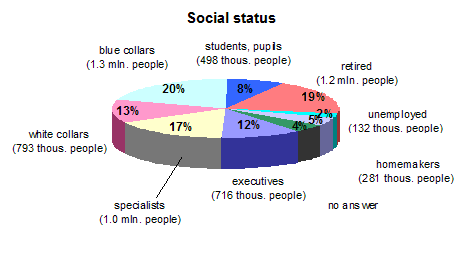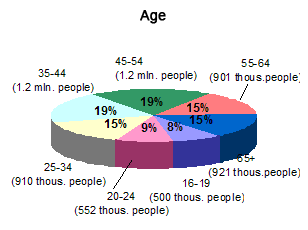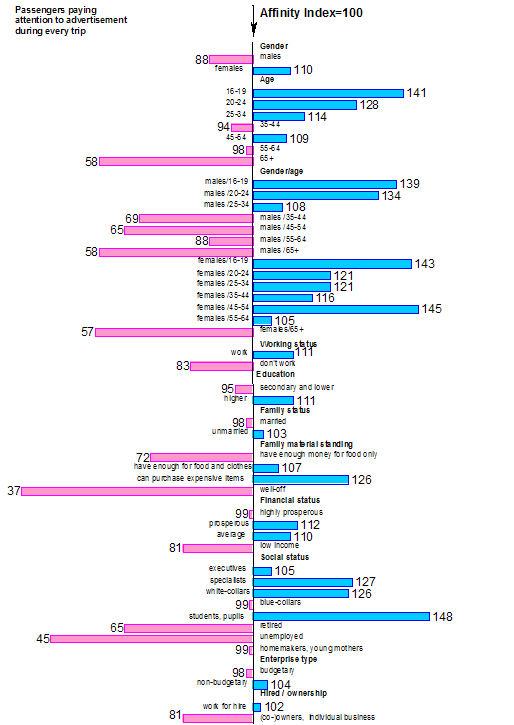Metro advertising efficiency in 2005
In spring 2005 TNS Gallup Media conducted a traditional annual study in order to assess the efficiency of advertisement placed in the Moscow metro. The main assessment goals were such indices as attentiveness to Metro advertisement, advertising media and a description of passengersТ social-and-demographic structure.
This research involved passengers from the Moscow Metro at the age of 16 and older and who are Moscow residents.
Like last year research this project included personal interviews taken from Moscow residents in the metro and a telephone inquiry of Moscow residents. It is worth mentioning that in accordance with the data on Moscow population volume provided by Goskomstat (Russian State Statistics Committee) the universe amount noticeably increased and reached 8.41 million people.
Phone interviews aimed at the assessment of passenger traffic flows showed that:
- On average the Metro is used by 73% of Moscow adult population per month (about 6,2 million people), on average per day Ц 36.6% of Moscow residents (more than 3.0 million people).
- On average 2.8 million people use the Metro twice and more often per day on weekdays and about 716 thousand people on weekends.
- More than 4.8 million people spend at least half an hour in the Metro on weekdays and 3.7 million people on weekends.
The proportion of passengers as per their social and demographic properties was also assessed:
- Metro passengers are represented by all demographic and social groups of the Moscow population.
- Approximately 57% of the Metro passengers (3.5million people) Ц women, 43% (2.7 million people) are men.

- The largest (in number) passengers age group are 35 to 44 years old Moscow residents and 45 to 54 years old passengers (each group makes up 19%, or 1.2 million people).

- More than 5.2 million of Moscow residents (85% of the Metro passengers) at least occasionally pay attention to various types of advertisement in the Metro. About 2.9 million people (47% of the passengers) pay attention to various advertising media during each trip by Metro.
- The following categories of people take notice of advertisement more often than any other group of passengers:
- 16-24 year old men
- 16-34 and 45-54 year old women
- people with higher education
- employed people
- specialists and white collars
- students
- middle-class and wealthy people.

TNS Gallup Media study of attentiveness to various advertising media showed that:
 |
According to the results of phone interviews approximately 71% of the Metro passengers (4.4 million people) take notice of boards on the Metro escalator vaults at least occasionally. About 35% of the passengers (2.2 million people) pay attention to this type of advertising media during each trip by Metro.
Personal interviews taken in the Metro showed that boards on the Metro escalator vaults attract attention of 91.8% of all the Metro passengers. During one trip by Metro more than 2/3 of the passengers (67%) pay attention to this type of advertising media. |
 |
In accordance with findings of the phone inquiry stickers inside carriages draw attention of 68% of the passengers (about 4.2 million people) at least from time to time. Around 27% of the Metro users (1.6 million Moscovites) pay attention to this type of advertisement media during each trip by Metro.
|
 |
Interviews taken by TNS Gallup Media employees in the Metro revealed that stickers inside carriages attract attention of 93.9% of the passengers not less than once a month and of 74.0% of the Metro passengers on average during one trip. |
 |
Judging by the results of interviews conducted by TNS Gallup Media in the Metro stickers on the carriage doors attract attention of 87.1% of the Metro passengers at least once a month. They interest 61.4% of the passengers on average during one trip. |
 |
Also the same interviews showed that stickers on the chamfer come into notice of 86.3% of the passengers at least once a month and of 59.4% of the Metro users on average during one trip. |
 |
Phone interviews showed that posters on the line walls in front of the platforms gain attention of 38% of the Metro passengers (2.3 million Moscovites) at least occasionally and of 11% of the passengers or 3.6 million people take notice to this type of advertisement media during each trip by Metro.
In accordance with findings of the interviews taken in the Moscow metro posters on the line walls in front of the platforms draw attention of 90.6% of the Metro users at least occasionally and of 59.7% of the passengers during one “average” trip.
|
 |
According to the results of the phone inquiry about 39% of the passengers (2.4 million people) take notice of stickers on the Metro stations doors at least sometimes. During each trip this type of advertising media meets the eye more than of 11% of the Metro passengers (697 thousand people).
Interviews taken by TNS Gallup Media employees in the Metro showed that stickers on the Metro stations exit/entrance doors attract attention of 74.1% of all the passengers at least once a month and of 40.0% of the passengers on average during one trip. |
 |
Telephone survey gave evidence of the fact that illuminated boards at the Metro station halls and passages call attention of about 26% of the passengers (approximately 1.6 million people) at least sometimes. During each trip this type of advertising media meets the eye of 6% of the Metro passengers (about 346 thousand people).
Interviews taken in the Metro showed that illuminated boards at the Metro station halls attract attention of 70.8% of the passengers at least sometimes and of 25.8% of the Metro users during one average trip.
|
 |
Interviews taken by TNS Gallup Media employees in the Metro showed that 68.0% of the Metro passengers pay attention to non-illuminated boards at the Metro station halls not less than once a month and 27.4% of the passengers on average during one trip. |
- Last year more then 1.6 million Moscovites took advantage of the contact details given in advertisement in the Moscow Metro.
Metro advertising efficiency in 2009
Metro advertising efficiency in 2008
Metro advertising efficiency in 2007
Metro advertising efficiency in 2006
Metro advertising efficiency in 2004 |